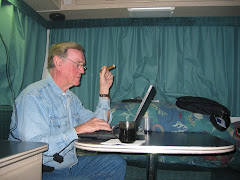

Hi Elysee, I'm Joe Camel Hey, Anything for us Ostrich's?
After leaving Kalgoorlie we headed south towards Esperance a town in the Great Australian Bight of the southern ocean and about as far from everything as one can get. We were scheduled to visit the Recherche Islands which was the site of great whale and seal hunting grounds from the 19th century. The name for islands were taken from two French ships that explored the area in the early part of the 19th century, raising concerns in London about French colonization and causing the British to spur settlement in the region. Thankfully, due to nine foot seas, our excursion to the islands was cancelled. Instead we visited Telegraph Farm, much to our good fortune. That is a place we easily could have passed by and I consider myself fortunate indeed that we left the pods of seals to another time.
The farm's owners John and Gwen Starr are pioneers in methods of farm diversification as an alternative to raising sheep. Sheep farms in Australia are consolidating, where a minimum of 4,000 sheep are necessary for. The Starr's 1300 acres were becoming insufficient. Instead of giving up farming they went the alternative way.
Animal husbandry is the main feature of Telegraph Farm's strategy. John raises, breeds and cross breeds animals adaptable to Australia, while producing animals that are leaner and more compatible with today's increasing understanding of nutrition and health.
For example, John has both Indian and African Buffalo and their cross strains, the same for African Wapiti, Canadian Elk. and ostrich. These animals are not only leaner they have less impact on the land. For example replacing Herefords with buffalo. During a recent drought the less particular buffalo didn't require feed, being content to graze on the course three foot high grass weeds. Not only that, but being draught animals the buffalo's method of walking is gentle and does not dig up the turf the way cattle do.
John keeps camels mainly for the enjoyment of children as Telegraph Farm is also a center of learning for children for miles around. We had no idea the animals were mostly hand fed and when the door to the van was opened, and Elysee had a bucket of feed in her hand, she was astonished and pleased to come face-to-face with Joe Camel (More on Telegraph Farm in my next posting)
